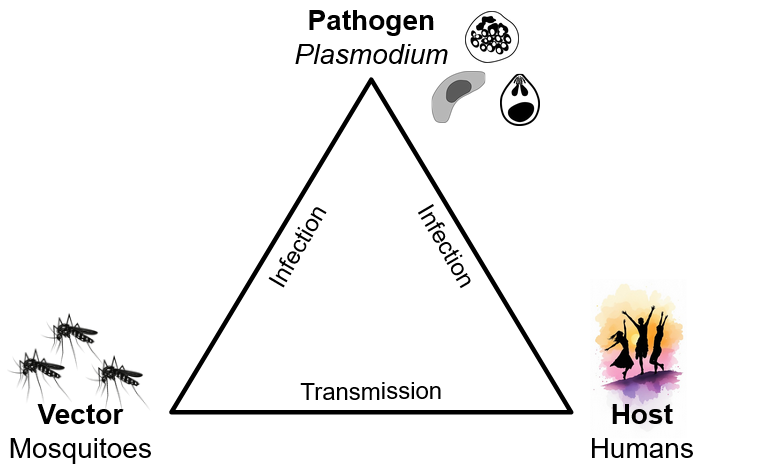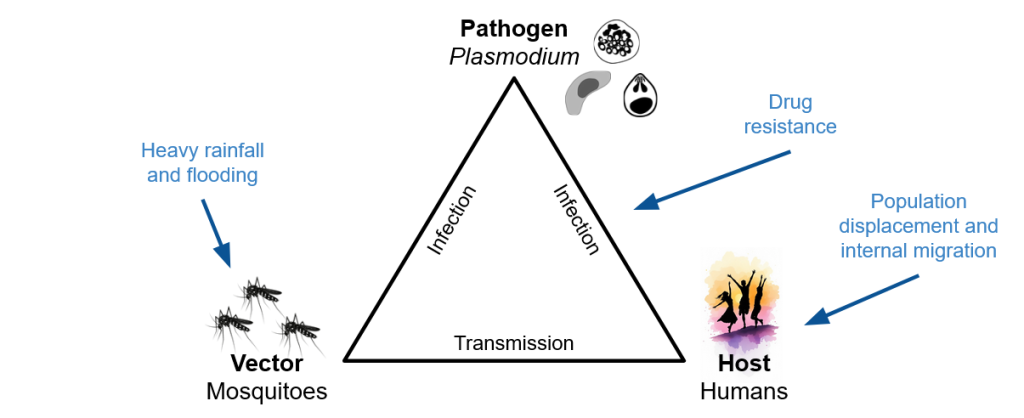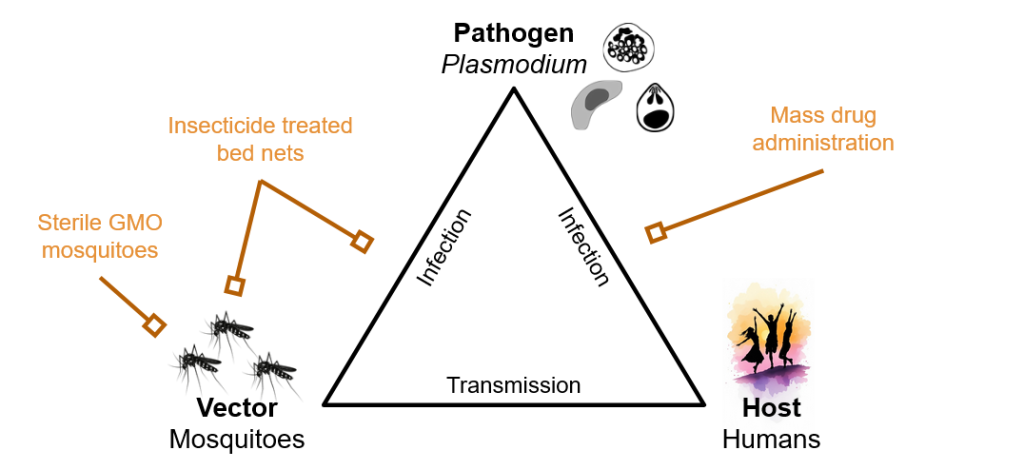O2. Malaria Disease Triangle
Michelle McCully
Learning Objectives
By the end of this chapter, you will be able to do the following:
- Communicate which organism or interaction on the malaria disease triangle is affected by factors that cause malaria
- Communicate which organism or interaction on the malaria disease triangle is affected by interventions that prevent malaria

Figure 1: The malaria disease triangle. [Image Description]
Malaria is a complex disease that requires a specific set of interactions to persist and spread. To conceptually simplify this system and guide intervention efforts, biologists and epidemiologists use the Disease Triangle framework. This model features three essential corners: the host (humans, who suffer the illness), the pathogen (the Plasmodium parasite, the causative agent), and the vector (the Anopheles mosquito, which carries the parasite). Crucially, the sides of the triangle are labeled to represent the active processes linking these corners: the relationship between Plasmodium and both the human and mosquito hosts is infection (as the parasite develops in both organisms), while the link between humans and mosquitoes is transmission. The key purpose of the Disease Triangle is to illustrate that the infectious cycle can only be sustained when all three corners are actively connected by these processes. Consequently, controlling malaria requires breaking any of the three links.
1. Factors that cause malaria
Understanding which part of the disease triangle is affected by different factors is key to designing effective public health strategies. Here we discuss how to represent on the disease triangle three different factors that contribute to malaria outbreaks. These factors increase infection, transmission, number of mosquitoes, or the human population density, so we would illustrate them with an arrow pointing at the relevant edge or corner of the triangle.

Figure 2: The malaria disease triangle with factors that cause an increase in malaria annotated. [Image Description]
Heavy rainfall and flooding
Affected Component: Vector (Mosquitoes)
Increased rainfall creates extensive, persistent bodies of stagnant water, which are the ideal larval habitats for Anopheles mosquitoes. This directly and dramatically increases the mosquito population size and density. The primary impact is on the sheer number of vectors available to transmit the disease, making the vector corner the most appropriate classification. While this ultimately leads to more transmission, the initial cause is the environmental support for the mosquito population itself.
Drug resistance in Plasmodium parasites
Affected Component: Infection (Edge between pathogen and host)
When the Plasmodium parasite develops resistance to standard antimalarial drugs (like chloroquine or artemisinin combination therapies), the medication fails to clear the infection from the human body. This allows infection to persist and the parasite to survive longer and remain viable for uptake by mosquitoes. The factor is a direct genetic change in the pathogen, but the effect prolongs the infection in humans and thus the human-to-mosquito infection reservoir. The mosquito-pathogen infection is unaffected.
Population displacement and internal migration
Affected Component: Host (Humans)
When large groups of people (due to conflict, natural disaster, or economic necessity) move from areas with low or no malaria into endemic zones, they often lack acquired immunity. Furthermore, they are often housed in crowded, non-screened shelters without access to bed nets or regular health services. This vulnerability directly impacts the host corner, making the human population significantly more susceptible to severe illness and less able to access preventative or curative care.
2. Interventions that prevent malaria
The most effective set of interventions will affect disease progression on multiple areas of the disease triangle and strategically target identified weaknesses. These interventions lower infection, transmission, or the number of mosquitoes, so we would illustrate them with a “T-bar” shaped arrow pointing at the relevant edge or corner of the triangle. Here we discuss how to represent on the disease triangle three different interventions to contain a malaria outbreak.

Figure 3: The malaria disease triangle with interventions that should prevent the spread of malaria annotated. [Image Description]
Mass drug administration
Affected Component: Infection (Edge between pathogen and host)
This intervention focuses on curing individuals quickly, thereby eliminating the Plasmodium parasite from the human host’s bloodstream. By reducing the overall parasite load in the human population, it removes the essential life stage of the parasite needed for mosquito uptake. The human is an essential component of the drug administration, as their behavior will affect the efficacy, and the parasite can only be targeted in this way while it is actively infecting a human. Therefore, the infection edge between the pathogen and host is the most appropriate target.
Distribution and proper use of insecticide-treated bed nets (ITNs)
Affected Component: Transmission (Edge between host and vector) and Vector (Anopheles Mosquitoes)
ITNs are designed to physically and chemically block the interaction between the human host and the mosquito vector, particularly at night when most feeding occurs. By preventing the mosquito from biting, the nets directly disrupt the disease exchange process. The goal of the net is to stop the successful transfer of the parasite between the two corners, this is the most direct attack on the transmission edge. The goal of the insecticide is to kill the mosquito, so this intervention would additionally target the vector corner.
Genetically engineered, sterile mosquitoes
Affected Component: Vector (Anopheles Mosquitoes)
This advanced technique involves releasing genetically modified male mosquitoes (often sterile or carrying gene drives that inhibit female offspring) into the wild. When these sterile males mate with wild females, they produce no or few viable offspring. The intervention’s goal is to cause a population crash by reducing successful reproduction, thereby dramatically shrinking the available biting vector pool. This is classified as a vector intervention because the entire strategy is aimed at reducing the size and reproductive fitness of the mosquito population.
Practice Questions
Image Descriptions
Figure 1: The image illustrates the transmission cycle of a pathogen called Plasmodium, using a triangular diagram. At the top of the triangle, “Pathogen Plasmodium” is labeled alongside three icons representing different life stages: a cluster of circular forms, a single elongated form, and a droplet-like shape. On the left side under “Vector,” there are illustrations of three mosquitoes, indicating they are responsible for transmission. The bottom corner labeled “Host” has a silhouette of three humans dancing against a colorful, abstract background. Arrows labeled “Infection” run from both Pathogen to Host and Host to Vector. The base has an arrow labeled “Transmission” pointing from Vector to Host. [Return to Figure]
Figure 2: The image depicts a triangular diagram illustrating the transmission cycle of a pathogen called Plasmodium. The triangle is centrally placed, labeled with “Transmission” at the base and “Infection” along both sides. At the top of the triangle, there are images representing the pathogen, including a spore, a cell, and a droplet icon. To the left of the triangle, there are three mosquitoes with the label “Vector” and the word “Mosquitoes” underneath. An arrow labeled “Heavy rainfall and flooding” points toward the mosquitoes. On the right side, there is an image of three human figures with raised arms under the label “Host” and the word “Humans.” Two arrows point toward the human figures, labeled “Drug resistance” and “Population displacement and internal migration.” The diagram is in black and white with blue arrows and labels. [Return to Figure]
Figure 3: The image portrays a diagram titled “Pathogen Plasmodium” with a triangular structure at the center. The triangle represents three interrelated elements: “Vector,” “Pathogen,” and “Host.” The top vertex of the triangle is labeled “Pathogen Plasmodium,” accompanied by small icons illustrating the pathogen. The left vertex is labeled “Vector Mosquitoes,” depicted with illustrations of mosquitoes. A line extends from this vertex labeled “Sterile GMO mosquitoes” and “Insecticide treated bed nets,” pointing to corresponding icons. The right vertex is labeled “Host Humans,” depicted with a silhouette of people, and a line labeled “Mass drug administration” connects to an icon here. The sides of the triangle are labeled “Infection,” indicating the movement between vertices. [Return to Figure]
Licenses and Attributions
“Malaria disease triangle” by Michelle McCully was written with assistance from Google Gemini 2.5 Flash. “Malaria disease triangle” is licensed under CC BY-NC 4.0.
Media Attributions
- 1C-O-2.0 Figure – malaria disease triangle © Michelle McCully is licensed under a CC BY-NC (Attribution NonCommercial) license
- 1C-O-2.1 Figure – triangle w causes © Michelle McCully is licensed under a CC BY-NC (Attribution NonCommercial) license
- 1C-O-2.2 Figure – triangle w interventions © Michelle McCully is licensed under a CC BY-NC (Attribution NonCommercial) license
